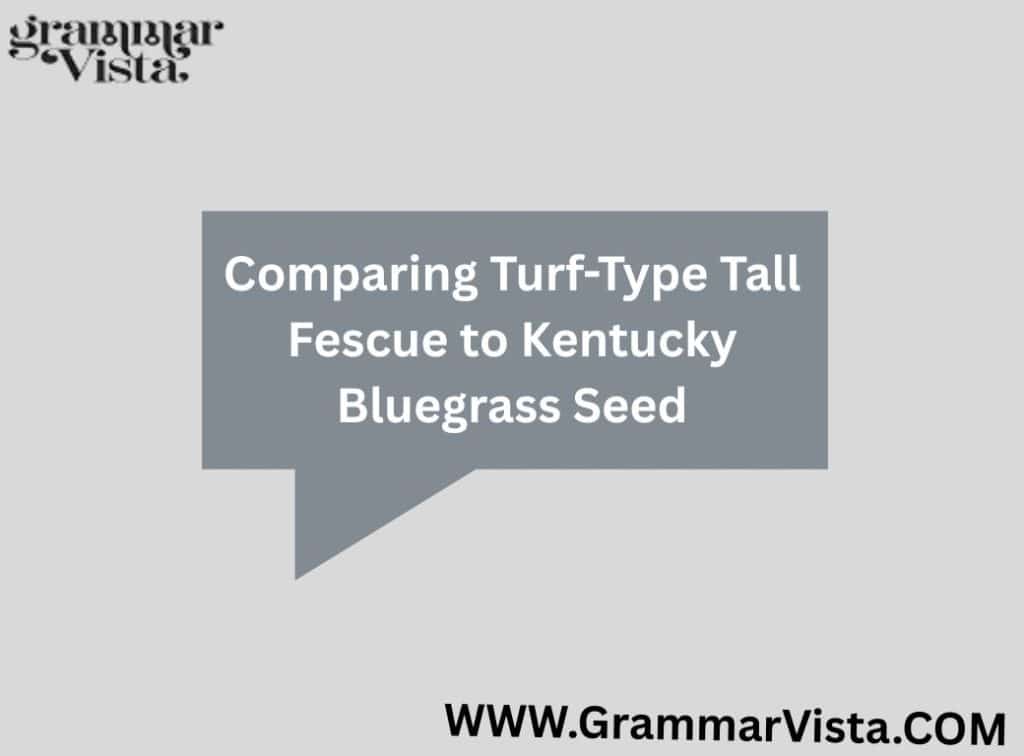Did you know that the right choice of grass seed can enhance your lawn’s appearance and also reduce maintenance costs? Among the most popular choices among homeowners and landscapers are turf-type tall fescue and Kentucky bluegrass.
Understanding the tall fescue vs kentucky bluegrass is crucial for anyone looking to achieve a lush, resilient lawn. In this reading, we’ll dive into their unique characteristics, growth habits, and ideal use cases to help you make an informed decision for your outdoor space.
Growth Habit and Appearance
Turf-type tall fescue boasts a distinct growth habit that sets it apart from Kentucky bluegrass. Unlike bluegrass, which spreads through underground rhizomes to form a lush, carpet-like lawn, tall fescue grows in clumps. This clumping tendency results in a dense, upright appearance that exudes toughness and also provides a unique texture.
While older fescue varieties tended to have coarser blades, newer hybrids now feature thinner, more refined blades that enhance their aesthetic appeal. This evolution in breeding allows homeowners to enjoy a robust lawn that doesn’t compromise on looks.
Kentucky Bluegrass grows quickly through underground stems called rhizomes, which allows it to fill in bare spots effectively and also contributes to its lush, dense texture. The fine blades of Kentucky Bluegrass create a soft, carpet-like lawn that exudes beauty, especially when illuminated by the sun’s rays, showcasing its vibrant green color.
Durability and Foot Traffic Tolerance
When it comes to durability and foot traffic tolerance, turf-type tall fescue stands out as the best choice for heavy foot traffic. Its deep roots anchor it firmly in the soil and also enhance its resilience against drought and wear.
This makes tall fescue an exceptional option for lawns that are often bustling with activity from kids or pets. The ability to withstand the rigors of everyday use without sacrificing aesthetic appeal is a significant advantage for homeowners seeking a robust lawn.
Kentucky bluegrass, while known for its lush, attractive appearance, can struggle under the pressure of heavy foot traffic. It tolerates moderate wear but tends to take longer to recover from damage, requiring more attention and care in high-use areas.
While its ability to spread and self-repair is commendable, it often falls short in comparison to the low-maintenance durability of tall fescue. For those who want a vibrant lawn that can handle the hustle and bustle of family life without constant upkeep, turf-type tall fescue proves to be the superior choice.
Water and Sun Requirements
When it comes to water and sun requirements, turf-type tall fescue holds a distinct advantage over Kentucky bluegrass. One of the standout features of tall fescue is its deep root system, which allows it to access moisture from deeper soil layers.
This adaptability makes it particularly valuable in regions with irregular rainfall or stringent watering restrictions, as it can thrive even when conditions turn dry. In contrast, Kentucky bluegrass prefers a more consistent moisture level and often struggles during prolonged dry spells unless supplemented with regular irrigation.
Sunlight also plays a crucial role in the performance of these grasses. While Kentucky bluegrass flourishes in full sun, requiring around six to eight hours of direct sunlight daily, turf-type tall fescue demonstrates remarkable versatility by tolerating partial shade.
This quality makes it an excellent choice for lawns with varying light conditions, offering homeowners flexibility in their landscaping options. Ultimately, for those looking to cultivate a resilient lawn that can withstand the challenges of fluctuating weather patterns, turf-type tall fescue emerges as the clear winner.
Maintenance and Mowing
When it comes to maintenance, turf-type tall fescue is a great choice if you want low maintenance. Unlike Kentucky bluegrass, which thrives during the spring and fall, tall fescue has a slower growth rate, particularly sideways.
This means you won’t have to worry as much about frequent trimming of edges or dealing with overgrowth, allowing you to enjoy your lawn without constant upkeep. Tall fescue requires less fertilizing, making it an attractive option for those who prefer a more hands-off approach to lawn care.
On the other hand, Kentucky bluegrass demands a bit more attention. Its rapid growth during peak seasons necessitates regular mowing to maintain its lush appearance and vibrant color. Homeowners who opt for Kentucky bluegrass should be prepared for a higher commitment in terms of both mowing frequency and fertilization.
This extra care can be rewarding, resulting in a thick, carpet-like lawn, but it does require a greater investment of time and resources. Ultimately, the choice between these two grass types hinges on your lifestyle and how much effort you’re willing to put into maintaining your outdoor space.
Establishment Time
When it comes to establishing a lush, green lawn, the speed of germination can make all the difference. Kentucky bluegrass takes 21 days or longer to sprout, which can feel like an eternity for eager homeowners looking to transform their outdoor spaces.
This lengthy establishment period can be a disadvantage, especially in climates where quick coverage is essential for preventing erosion or weed invasion.
In contrast, turf-type tall fescue germinates much faster, typically within 7 to 12 days. This rapid emergence not only allows homeowners to enjoy a lush lawn sooner but also provides an earlier opportunity for mowing and maintenance.
The quicker establishment of tall fescue means that it can adapt more readily to changing weather conditions, making it an ideal choice for those seeking a resilient lawn that thrives in a variety of environments. For anyone looking to create a green oasis without the wait, turf-type tall fescue offers a compelling option that delivers results in record time.
Which One Should You Choose? | Kentucky Bluegrass vs Tall Fescue
When considering your lawn’s aesthetic and resilience, turf-type tall fescue emerges as a compelling choice for those seeking a robust, drought-resistant lawn that demands less upkeep. Its deep root system allows it to thrive in arid conditions and also makes it adaptable to a variety of soil types.
Plus, if your yard has shaded spots, turf-type tall fescue shines as an excellent option, providing a lush green carpet without the constant need for water and maintenance.
On the other hand, Kentucky bluegrass offers a soft, attractive lawn that is the epitome of traditional beauty. With its fine texture and rich color, it creates a stunning landscape that many homeowners desire. But, be prepared to invest time and effort into its care—Kentucky bluegrass typically requires regular watering and can be susceptible to disease in warmer climates.
Ultimately, your choice will hinge on your priorities: if you crave low-maintenance durability, turf-type tall fescue is your go-to; if you’re willing to nurture a delicate, picturesque lawn, then Kentucky bluegrass might just be worth the extra work.
Conclusion
Selecting fescue vs bluegrass seed ultimately hinges on your specific environmental conditions, lawn usage, and maintenance preferences. Turf-type tall fescue is an excellent choice for those in warmer climates or for homeowners seeking a drought-resistant option that requires less upkeep.
Conversely, Kentucky bluegrass thrives in cooler regions and offers a lush, dense lawn that many find visually appealing. Both grass types have their unique advantages and can flourish with the right care and attention. Take some time to evaluate your needs and make an informed decision to create the lawn of your dreams!







